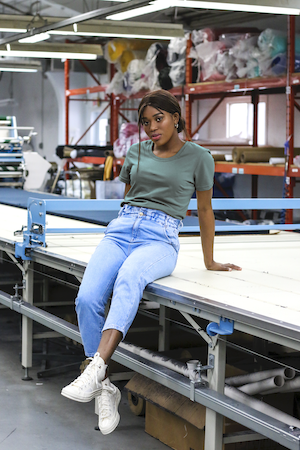Eye On Apparel: Green And Loving It

kikk / petrmalinak / Lauritta / sunset lady / Shutterstock.com
Not too long ago, selling eco-friendly apparel or enforcing green production processes were details that set apparel and footwear manufacturers, decorators and brands apart from competitors, especially those in fast fashion. It was something new, unique and interesting, and it represented a forward focus and a greater overall purpose. Today, it’s become the standard, and many consumers not only expect companies to demonstrate some level of active involvement in sustainability efforts, but also to offer products that genuinely reflect this commitment as well.
During the pandemic, consumers became more interested in changing their personal shopping behaviors, including the products they buy and the brands they give their business to, to contribute to a more sustainable world for all. With consumers spending more time at home last year, pandemic-related lockdowns and precautionary measures allotted more time to experiment with and develop new habits, according to PricewaterhouseCoopers’ June 2021 Global Consumer Insights Pulse Survey. Another survey conducted in 2020 by Boston Consulting Group, which collected insights from 3,000 consumers across eight countries, found that 70 percent of consumers feel they are more aware post-pandemic of human activities that are threatening to the environment, and how environmental degradation poses a threat to health, safety and well-being. Moving forward, one-third of respondents said they’re practicing sustainable behaviors consistently and about one-fourth said they’re doing so more robustly.
“When using eco-friendly products, it’s important for both the client and their consumer to fully understand how their use of the product is contributing to preserving our Earth. We like the idea that you can be eco-friendly without having to change much of your daily life, it’s just that most people aren’t aware of how easy it is to be eco-friendly and sustainable when making purchasing choices, so it’s our duty as the supplier to educate our clients,” says Lauren Piller, sales and marketing specialist with Eco Marketing Solutions, an Austin, Texas, distributor that specializes in green promotional products solutions. “I’m noticing a lot more requests for eco-friendly apparel and home kitchen goods. To me, this means that not only are we growing consciously in large-scale corporate organizations, but also in everyday aspects of life as simple as switching out plastic straws for reusable straws for tumblers.”
With consumers ready, willing and interested in committing to greener practices, they’re looking to brands to help direct action and follow the mission through. Consumers today highly value transparency, and for brands to clearly and easily share information about the contents of their products and also their origins. The 2020 Consumer Survey Key Findings report published by nonprofit global movement Fashion Revolution—which surveyed 5,000 consumers across Germany, France, Italy, Spain and the UK to learn what consumers are looking for when it comes to brands’ social and environmental impact—found that 78 percent of consumers want brands to provide thorough information about a product’s environmental impact, and 70 percent want brands to provide info about the wages and working conditions of people in the supply chain.
Consumers expect companies to do more than simply sell products, but they’re also willing to contribute to the effort. In a survey of 18,980 consumers across 28 countries published last year by IBM Institute for Business Value, in association with National Retail Federation, 71 percent of respondents said that traceability is so important to them, that they’d be willing to pay a premium for brands that support recycling, practice sustainability, and/or are environmentally responsible.
––––––––––––––––––––––––––––––––––––––––––––––––––––––––––––––––––––––––––
![]()
Sustainable fashion is in style, not only because of its giveback component, but also because many available styles are trending, commonly appearing in high-fashion shows worldwide. Read below for a few timely options to consider in eco-friendly apparel.
Beloved sweatpants.
The past two years have seen marked shifts in consumers’ day-to-day dress. Many people underwent a transition of business professional and casual to loungewear and athleisure, to a combination of both (business casual on top, sweatpants on the bottom) for meetings on Zoom. Now, consumers are continuing to make comfort a priority, with casual loungewear—sweatpants paired with a Zoom-appropriate t-shirt—remaining a top trend in eco wear, according to Goodonyou.eco.
Recycled and upcycled fashion.
Recycled materials have long been a staple of fashion-design students and designers everywhere, and reused, recycled and reclaimed fabrication has always been a go-to for creative takes on purposeful design. Recent collections by Marine Serre and Coach showcased the use of upcycled designs on the runway, with French designer Marine Serre featuring fine leather patchwork jackets made from different-colored scraps of leather, and Coach’s (Re)Loved collection which offers a selection of “rescued” and restored handbags. And one of the longstanding pioneers in the space of sustainable fashion all around, Stella McCartney, has been designing ready-to-wear fashion since the ’90s, and offers clothing that’s made from reengineered cashmere, ethically sourced wool and recycled materials that are cruelty-free (no fur or leather), 100-percent PVC-free, and wrapped in sustainable packaging.
Alternative fabrics and blends.
Companies are now experimenting with how to offer sustainable fabrics on a larger scale, thus making eco-friendlier options more affordable and widely available to more consumers. From cactus leather to rose petal silk to Piñatex—a plant-based leather made from the fibers extracted from fallen and discarded pineapple leaves—alternative fabric selections are becoming more creative, and also offering companies more options that make sense for their brand and customers. There are many fabrication variations to choose from that require less energy consumption, less water and fewer chemicals. Some of the more accessible options include polyester made from recycled plastics, organic cotton, linen and hemp.
––––––––––––––––––––––––––––––––––––––––––––––––––––––––––––––––––––––––––
![]()
With consumers not only interested in eco-conscious products, supply chain practices and brand involvement, there’s certainly potential for brands to benefit and profit as well. With sustainability transforming into somewhat of a buzz word, it can appear daunting for brands to consider how to approach the concept while also remaining authentic. A 2020 report from IBM Institute for Business Value, in association with National Retail Federation, outlines four actionable steps that companies can take to strategic plan their green goals:
- Earn consumers’ confidence through transparency and traceability.
- Factor in consumers’ willingness to contribute to the cause.
- Leverage sustainability as a driver for end-to-end operations.
- Align sustainability initiatives to your core competency.
––––––––––––––––––––––––––––––––––––––––––––––––––––––––––––––––––––––––––

The ongoing supply chain problems the promotional products industry is facing have resulted in a lack of available stock and inventory. If a client’s first choice isn’t available, it can be helpful to provide a few complementary alternatives at different price points. This helps them see the advantages of each choice—and also can increase your chance of making the sale. Here’s two.
Good, better and best solutions were determined by quality, style, price and eco-consciousness, which included fabrication, manufacturing and supply chain processes, and related efforts, such as environmental activism or impact associated with a particular product or collection.
![]()
General client request: eco-friendly, lightweight, fleece jacket in black and/or dark grey
Good, better and best solutions:
![]()
The Champion® Double Dry Eco® Quarter-Zip Pullover has details that include a fleece-lined cadet collar, a quarter-zip covered zipper and the “C” logo on the left sleeve. Made from a blend of 50-percent cotton and 50-percent polyester, which includes up to five-percent recycled polyester from plastic bottles. Additional features include forward shoulders and a side slash pouch to allow for full front printing. Available in S-3XL in light steel, navy and black (shown).
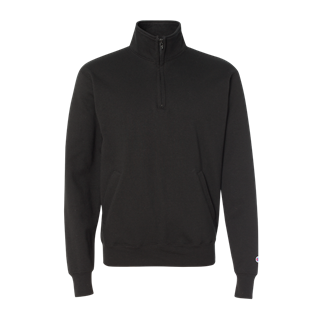
S & S Activewear / PPAI 256121, S12 / www.ssactivewear.com
––––––––––––––––––––––––––––––––––––––––––––––––––––––––––––––––––––––––––
![]()
Made from a blend of 80-percent polyester fleece and 20-percent recycled polyester, the 9002 Horizon Fleece Jacket features convenient details, such as zippered side pockets and a snap-button chest pocket. It also features woven patches on the shoulder and upper back for added style, and despite being lightweight, it’ll keep wearers warm and cozy. Available in S-5XL in navy or black (shown).
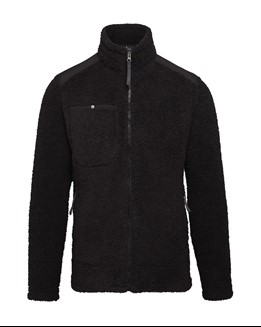
Fossa Apparel, Inc. / PPAI 330885, S1 / www.fossaapparel.com
––––––––––––––––––––––––––––––––––––––––––––––––––––––––––––––––––––––––––
![]()
A style that recently transitioned to eco-friendly, the Over-Achiever Sweaterfleece Jacket is made from fabric that uses between 26 and 32 recycled bottles per garment and available in complementary men and women’s styles. With a fabrication blend of 80-percent recycled polyester and 20-percent polyester sweater fleece, it has the hand of performance fleece and the look of heathered wool. Available in men’s S-5XL in four colors, shown in two-tone stone gray/cinder (shown) and women’s XS-3XL in five colors.
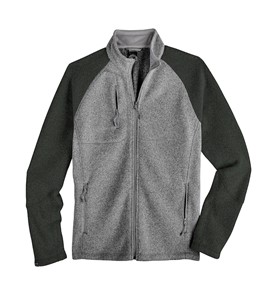
Storm Creek / PPAI 438091, S6 / www.stormcreek.com
––––––––––––––––––––––––––––––––––––––––––––––––––––––––––––––––––––––––––
![]()
General client request: sustainably made, midweight, crew-neck t-shirt in red
Good, better and best solutions:
![]()
Made from 100-percent recycled fabric and never re-dyed, the District® Re-Tee® is manufactured using reclaimed materials that were otherwise destined for a landfill. A midweight, 5.3-ounce tee, its fabrication is comprised of 60-percent recycled cotton and 40-percent post-consumer recycled polyester. Additional details include a one-by-one inch rib-knit neck, shoulder-to-shoulder taping and a tag-free label. Available in XS-4XL in nine colors, shown in ruby red.
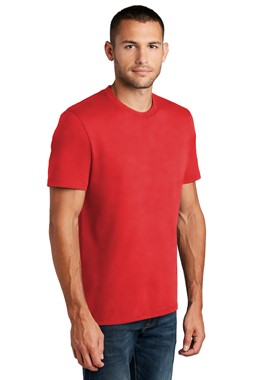
SanMar / PPAI 110788, S16 / www.sanmar.com
––––––––––––––––––––––––––––––––––––––––––––––––––––––––––––––––––––––––––
![]()
Each Unisex Eco Performance T-Shirt helps recycle approximately three polyester (RPET) bottles. With a soft hand, it’s made from 70-percent recycled material, which includes 30-percent recycled cotton and 40-percent recycled polyester RPET, as well as 30-percent cotton. Pre-shrunk with a retail fit, it features a one-by-one inch baby rib set-in collar, side seams and a tearaway label. Available in sizes XS-3XL in 10 colors, shown in heather red.
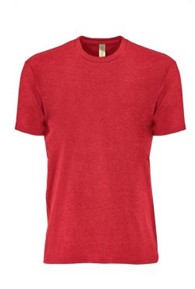
Next Level Apparel / PPAI 272027, S3 / www.nextlevelapparel.com
––––––––––––––––––––––––––––––––––––––––––––––––––––––––––––––––––––––––––
![]()
It’s no wonder why the Signature Crew is one of Marine Layer’s top-sellers. The unisex tee is made from the supplier’s custom signature fabric blend, which is 50-percent Supima cotton and 50-percent MicroModal, which is derived from recycled beechwood, a natural and sustainable raw material. Manufactured sustainably in California, it’s available in sizes XS-3XL and can be PMS color-matched to any shade imaginable.
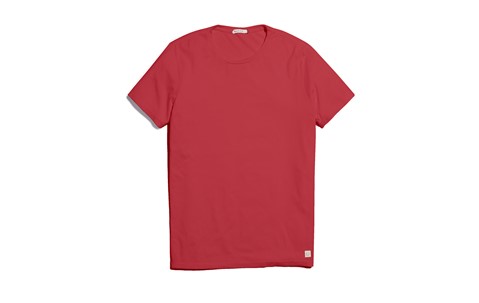
Marine Layer, Inc. / PPAI 690355, S1 / www.marinelayer.com
––––––––––––––––––––––––––––––––––––––––––––––––––––––––––––––––––––––––––

Playing off the trend of loungewear, sweatpants in particular, the Unisex Organic Fleece Jogger Pant are so comfy, you can bet wearers will be sporting them during their upcoming Zoom calls. Manufactured in the U.S., these sweats are made from 100-percent certified-organic cotton fleece that’s also super soft. Features include side pockets, set-on rib cuffs, an elastic waistband with a drawcord and a satin label. Available in sizes XS-3XL in night, slate, nautical blue and ocean (shown).
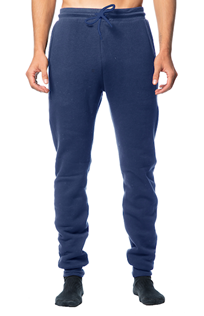
Royal Apparel / PPAI 269959, S1 / www.royalapparel.net
––––––––––––––––––––––––––––––––––––––––––––––––––––––––––––––––––––––––––
The Women’s Lithium Quilted Hooded Parka is sustainably built for the cooler weather. Made from 100-percent recycled polyester, which includes certified-recycled PET bottles, this lightweight, 1.62-ounce jacket also features Primaloft fill to keep wearers toasty. Available in sizes X3-3XL in black and navy (shown), with a complementary men’s style available in sizes S-3XL.
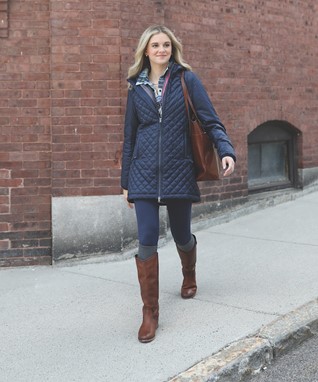
Charles River Apparel / PPAI 111644, S10 / www.charlesriverapparel.com
––––––––––––––––––––––––––––––––––––––––––––––––––––––––––––––––––––––––––
The Women’s T-Shirt “The Classic” is a relaxed-fit, easy-wear wardrobe essential. Part of the Ethica Collection, it’s available in both heather and solid colors, with heather colors made from a blend of 50-percent organic cotton and 50-percent recycled polyester, and solid colors made from 100-percent organic cotton. Union-made in Canada all within a 500-mile radius, it’s available in sizes XS-2XL in 10 colors, shown in spruce.
ATTRACTION, Inc. / PPAI 474094, S1 / www.attraction.com
––––––––––––––––––––––––––––––––––––––––––––––––––––––––––––––––––––––––––
The North Face® Ladies Everyday Insulated Jacket is designed to complement wearers as they do their day-to-day errands and enjoy some extra time in the great outdoors, too. Made from recycled fabrications, its WindWall™ shell is derived from 100-percent recycled polyester taffeta, which features a durable, water-repellent finish and lining. The jacket also features Heatseeker™ synthetic insulation to keep wearers warm and dry, with details including a Vislon® center-front zipper, secure-zip hand pockets and contrast-embroidered The North Face logo on the left sleeve and right shoulder blade. Available in sizes S-2XL in shady blue, TNF black and vintage white (shown).
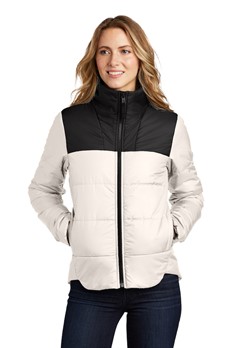
SanMar / PPAI 110788, S16 / www.sanmar.com
––––––––––––––––––––––––––––––––––––––––––––––––––––––––––––––––––––––––––
A sustainable product that’s wearable almost year-round and can be paired with any outfit, is the Unisex Eco Triblend Infinity Scarf. Offering a soft hand and ample room for embellishment, the scarf measures 60 to 70 inches in circumference and 26 inches in length, depending on the color. It’s also made in the U.S.A. from a blend of 50-percent RPET recycled plastics, which is derived from plastic bottles, along with 37-percent combed ring-spun organic cotton and 13-percent rayon. Shown in eco tri royal.
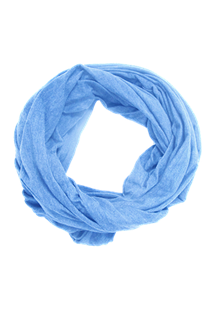
Royal Apparel / PPAI 269959, S1 / www.royalapparel.net
––––––––––––––––––––––––––––––––––––––––––––––––––––––––––––––––––––––––––
The custom neckties designed by Knotty Tie Co. continue to make an impact through sustainability and social impact. The supplier, which employs refugees and actively works to empower these workers, sources custom-woven fabrics made from recycled plastics, in addition to upcycled and recycled one-of-a-kind fabrics. Made fully in the U.S. in the supplier’s Denver, Colorado, facilities, the neckties are made from recycled polyester twill and are available in standard, long and extra-long sizes, and Knotty (bowtie), classic or skinny styles.
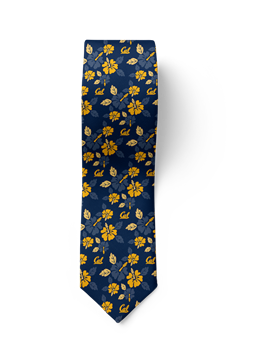
Knotty Tie Co. / PPAI 720849, S1 / www.promo.knottytie.com
––––––––––––––––––––––––––––––––––––––––––––––––––––––––––––––––––––––––––
The Recycled Performance Cap is a way to extend a green message year-round. Featuring an unstructured, six-panel, mid profile, this hat is made from 95-percent sustainable polyester and five-percent spandex, and features a pre-curved visor, a D-ring micro hook-and-loop closure and a performance sweatband. Available in four colors, shown in heather maroon.
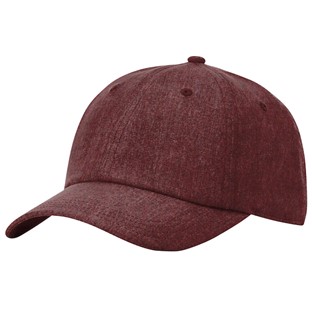
Kati Sportcap / PPAI 113758, S5 / www.katisportcap.com
––––––––––––––––––––––––––––––––––––––––––––––––––––––––––––––––––––––––––
Danielle Renda is associate editor of PPB.


